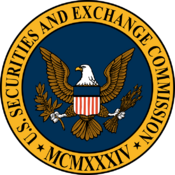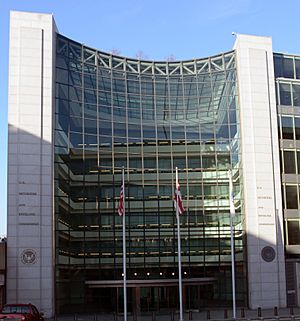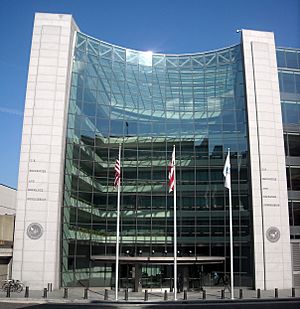United States Securities and Exchange Commission facts for kids

Seal of the U.S. Securities and Exchange Commission
|
|

U.S. Securities and Exchange Commission headquarters in Washington, D.C.
|
|
| Agency overview | |
|---|---|
| Formed | June 6, 1934 |
| Jurisdiction | United States federal government |
| Headquarters | Washington, D.C., U.S. |
| Employees | 4,807 (2022) |
| Agency executive |
|
The United States Securities and Exchange Commission (SEC) is a special government agency in the United States. It was created after a big stock market crash in 1929. The SEC's main job is to make sure people play fair in the stock market and don't cheat. It helps protect investors and keeps financial markets working smoothly.
The SEC was officially started by a law called the Securities Exchange Act of 1934. It also helps enforce other important laws like the Securities Act of 1933.
Contents
What the SEC Does
The SEC has three main goals:
- To protect people who invest their money.
- To keep markets fair, orderly, and efficient.
- To help companies raise money to grow.
Protecting Investors and Fair Markets
To achieve its goals, the SEC makes sure that public companies share important information. Companies must send in quarterly and annual reports. These reports tell investors how the company is doing financially. They also include a "management discussion and analysis" (MD&A). This part explains the company's past performance and its plans for the future.
These reports are very important for investors. They help people make smart choices when they invest in the stock market. Unlike money in a bank, investments in the stock market are not guaranteed by the government. This means you can gain a lot, but you can also lose money. By making companies share information, the SEC helps everyone have the same basic facts. This helps reduce insider trading and fraud.
The SEC also has an online database called EDGAR. Investors can use EDGAR to find all the information companies file with the agency. You can also send tips and complaints to the SEC through this system. This helps the SEC find people who break the rules. The SEC also offers educational materials to help people learn about investing.
History of the SEC
Why the SEC Was Needed
Before the SEC, states had their own laws about selling stocks, called "blue sky laws." These laws were supposed to protect people from fraud. However, they weren't very effective. It was easy for people to get around them, especially by selling stocks across state lines.
How the SEC Started
The SEC's power came from two major laws: the Securities Act of 1933 and the Securities Exchange Act of 1934. These laws were part of President Franklin D. Roosevelt's New Deal program.
The Securities Act of 1933 made sure that companies selling new stocks had to register them. This meant they had to provide financial information so investors could make informed decisions. At first, another agency, the Federal Trade Commission, enforced this law.
Then came the Securities Exchange Act of 1934. This law regulated the buying and selling of stocks between people and companies. It also created the SEC and gave it the job of enforcing both the 1933 and 1934 laws.

In 1934, President Roosevelt chose his friend Joseph P. Kennedy to be the first chairman of the SEC. Kennedy was a very successful businessman. He brought in many smart young lawyers to work at the SEC.
Kennedy's team had four main goals:
- To make investors trust the stock market again.
- To stop cheating and bad practices that hurt investors.
- To end insider trading by top company officials.
- To create a clear system for registering stocks sold in America.
The SEC was successful in its mission. Kennedy helped reassure American businesses and ordinary investors. He encouraged people to return to the market, which helped the economy grow.
Since 1994, most of the information filed with the SEC can be found online through the EDGAR system.
The SEC in the 21st Century
In 2019, the SEC Historical Society launched an online gallery. It shows how the U.S. stock market has changed since the 1930s. It includes stories, documents, interviews, photos, and videos.
Leaders of the SEC
The SEC has had many leaders, called chairmen or chairwomen, throughout its history. Here is a list of some of them:
| No. | Portrait | Name | State of residency | Term of office | Appointed by | ||
|---|---|---|---|---|---|---|---|
| Term start | Term end | Time in office | |||||
| 1 |  |
Joseph P. Kennedy Sr. | Massachusetts | June 30, 1934 | September 23, 1935 | 1 year, 85 days | Roosevelt |
| 2 |  |
James M. Landis | Massachusetts | September 23, 1935 | September 15, 1937 | 1 year, 357 days | |
| 3 | William O. Douglas | Connecticut | August 17, 1937 | April 15, 1939 | 1 year, 241 days | ||
| 4 |  |
Jerome Frank | Illinois | May 18, 1939 | April 9, 1941 | 1 year, 326 days | |
| 5 |  |
Edward C. Eicher | Iowa | April 9, 1941 | January 20, 1942 | 286 days | |
| 6 |  |
Ganson Purcell | January 20, 1942 | June 30, 1946 | 4 years, 161 days | ||
| 7 | James J. Caffrey | July 23, 1946 | December 31, 1947 | 1 year, 161 days | Truman | ||
| 8 | Edmond M. Hanrahan | New York | May 18, 1948 | November 3, 1949 | 1 year, 169 days | ||
| 9 | Harry A. McDonald | November 4, 1949 | February 25, 1952 | 2 years, 113 days | |||
| 10 | Donald C. Cook | Michigan | February 26, 1952 | June 17, 1953 | 1 year, 111 days | ||
| 11 | Ralph H. Demmler | Pennsylvania | June 27, 1953 | May 25, 1955 | 1 year, 332 days | Eisenhower | |
| 12 | J. Sinclair Armstrong | New York | May 25, 1955 | June 27, 1957 | 2 years, 33 days | ||
| 13 | Edward N. Gadsby | Massachusetts | August 20, 1957 | March 26, 1961 | 3 years, 218 days | ||
| 14 | William L. Cary | March 27, 1961 | August 20, 1964 | 3 years, 146 days | Kennedy | ||
| 15 | Manuel F. Cohen | August 20, 1964 | February 22, 1969 | 4 years, 186 days | Johnson | ||
| 16 |  |
Hamer H. Budge | Idaho | February 22, 1969 | January 2, 1971 | 1 year, 314 days | Nixon |
| 17 |  |
William J. Casey | New York | April 14, 1971 | February 2, 1973 | 1 year, 294 days | |
| 18 | G. Bradford Cook | Nebraska | March 3, 1973 | May 16, 1973 | 74 days | ||
| 19 | Ray Garrett Jr. | Illinois | August 6, 1973 | October 28, 1975 | 2 years, 83 days | ||
| 20 | Roderick M. Hills | California | October 28, 1975 | April 10, 1977 | 1 year, 164 days | Ford | |
| 21 | Harold M. Williams | California | April 18, 1977 | March 1, 1981 | 3 years, 317 days | Carter | |
| 22 | John S. R. Shad | May 6, 1981 | June 18, 1987 | 6 years, 43 days | Reagan | ||
| 23 | David Sturtevant Ruder | Illinois | August 7, 1987 | September 30, 1989 | 2 years, 54 days | ||
| 24 | Richard C. Breeden | New York | October 11, 1989 | May 7, 1993 | 3 years, 208 days | Bush Sr. | |
| – |  |
Mary Schapiro (acting) | New York | May 7, 1993 | July 27, 1993 | 81 days | Clinton |
| 25 |  |
Arthur Levitt | New York | July 27, 1993 | February 9, 2001 | 7 years, 227 days | |
| 26 | Harvey Pitt | New York | August 3, 2001 | February 18, 2003 | 1 year, 199 days | Bush Jr. | |
| 27 |  |
William H. Donaldson | New York | February 18, 2003 | June 30, 2005 | 2 years, 132 days | |
| 28 |  |
Christopher Cox | California | August 3, 2005 | January 20, 2009 | 3 years, 170 days | |
| 29 |  |
Mary Schapiro | New York | January 27, 2009 | December 14, 2012 | 3 years, 322 days | Obama |
| 30 |  |
Elisse B. Walter | New York | December 14, 2012 | April 10, 2013 | 117 days | |
| 31 |  |
Mary Jo White | New York | April 10, 2013 | January 20, 2017 | 3 years, 285 days | |
| – |  |
Michael Piwowar (acting) | Washington D.C. | January 20, 2017 | May 4, 2017 | 104 days | Trump |
| 32 |  |
Jay Clayton | Pennsylvania | May 4, 2017 | December 23, 2020 | 3 years, 233 days | |
| – |  |
Elad Roisman (acting) | Maine | December 24, 2020 | January 20, 2021 | 27 days | |
| – |  |
Allison Lee (acting) | Washington D.C. | January 20, 2021 | April 17, 2021 | 87 days | Biden |
| 33 |  |
Gary Gensler | Maryland | April 17, 2021 | January 20, 2025 | 3 years, 278 days | |
| – |  |
Mark Uyeda (acting) | California | January 20, 2025 | April 21, 2025 | 91 days | Trump |
| 34 |  |
Paul S. Atkins | Virginia | April 21, 2025 | Present | 230 days | |
How the SEC is Organized
Commission Members
The SEC is led by five commissioners. The President of the United States chooses them. No more than three commissioners can be from the same political party. They serve for five years. The President also picks one commissioner to be the chairman, who is the top leader of the SEC.
Current Commissioners
Here are the current leaders of the SEC:
| Position | Name | Party | Took office | Term expires |
|---|---|---|---|---|
| Chair | Paul S. Atkins | Republican | April 21, 2025 | June 5, 2026 |
| Member | Hester Peirce | Republican | January 11, 2018 | June 5, 2025 |
| Caroline A. Crenshaw | Democratic | August 17, 2020 | June 5, 2024 | |
| Mark Uyeda | Republican | June 30, 2022 | June 5, 2028 | |
| Vacant | N/A | — | June 5, 2027 |
SEC Divisions and Their Jobs

The SEC has six main divisions, each with a special job. Its main office is in Washington, D.C..
The SEC's divisions are:
- Corporation Finance
- Trading and Markets
- Investment Management
- Enforcement
- Economic and Risk Analysis
- Examinations
Corporation Finance checks the information that public companies share. It also looks at how companies register big deals like mergers. This division also runs the EDGAR system.
The Trading and Markets division watches over stock exchanges like the New York Stock Exchange. It also oversees groups that set rules for brokers and investment firms. This division helps make sure the industry follows the rules.
The Investment Management division oversees companies that manage investments, like mutual funds. It also watches over people who give investment advice. This division helps make sure these groups follow federal laws.
The Enforcement division investigates when people or companies might have broken securities laws. It can take legal action against them. This is the largest division at the SEC. It can file lawsuits or hold special hearings. The SEC can also tell other government lawyers about serious cases.
The Economic and Risk Analysis division (DERA) uses economics and data to help the SEC. It helps with making rules, enforcing laws, and checking companies. DERA helps the SEC understand new financial products and risks. It also creates tools to find patterns that might show rule-breaking.
The Division of Examinations checks companies and markets to make sure they are following the rules. This helps protect investors and keeps markets fair. The results of these checks help the SEC make new rules and find risks.
Regional Offices
The SEC has 11 offices across the United States. These offices help the SEC work closer to people and companies in different areas.
- Atlanta – Nekia Hackworth Jones
- Boston – Silvestre A. Fontes
- Chicago – Daniel Gregus
- Denver – Jason Burt
- Fort Worth – Eric R. Werner
- Los Angeles – Katharine Zoladz, J. Cindy Eson
- Miami – Eric I. Bustillo
- New York City – Antonia M. Apps
- Philadelphia – Nicholas P. Grippo
- Salt Lake City – Tracy S. Combs
- San Francisco – Monique Winkler
The SEC also has other important offices:
- The Office of General Counsel acts as the SEC's lawyer. It gives legal advice to the commission.
- The Office of the Chief Accountant sets and enforces rules for how companies do their accounting.
- The Office of International Affairs works with other countries' financial regulators. This helps deal with financial issues that cross borders.
- The Office of Information Technology helps the SEC with all its computer and technology needs.
- The Inspector General checks if the SEC itself is working well and following its own rules.
- The SEC Office of the Whistleblower helps people who report possible violations of securities laws.
How the SEC Communicates
Comment Letters
The SEC's Corporation Finance division sends "comment letters" to companies. These letters ask companies for more information about their public filings. They might ask the company to change their reports or how they share information in the future. The company must reply to each question. This back-and-forth communication is later made public.
No-Action Letters
Sometimes, the SEC staff sends "no-action letters." These letters say that the SEC staff will not recommend taking action against a company for a specific activity. This happens when the legal rules for an activity are not clear. These letters are made public and help everyone understand what is allowed.
SEC Operations
Important Actions by the SEC
The SEC's Enforcement Division has taken many important actions. For example, in 2008, the SEC made new rules to stop certain types of "naked short selling." This was done to help calm down the stock market during a difficult time. The SEC also investigates people who try to trick the market by spreading false rumors.
Working with Cryptocurrency
The SEC has been very active in the world of cryptocurrencies. In 2023, the SEC filed charges against major crypto companies like Binance and Coinbase. The SEC believes that many crypto assets are like traditional stocks and bonds, which are called "securities."
The SEC uses a test called the Howey Test to decide if something is a security. This test comes from a 1946 Supreme Court decision. It says a security is "an investment of money in a common enterprise with profits to come solely from the efforts of others." The SEC says many crypto assets fit this definition. However, some people in the crypto world think this test is old and doesn't fit new digital currencies.
Cybersecurity Rules
On July 26, 2023, the SEC made a new rule about cybersecurity. This rule, called the Cybersecurity Risk Management, Strategy, Governance, and Incident Disclosure rule, encourages public companies to be open about their cybersecurity risks. It also helps them manage these risks better.
Climate Disclosure Rule
In 2024, the SEC created a new rule about climate change. It's called "The Enhancement and Standardization of Climate-Related Disclosures for Investors." This rule asks companies to share information about how climate change might affect their business. It also asks about their greenhouse gas emissions.
Whistleblower Program
The SEC has a program that rewards people who report violations of securities laws. This "whistleblower" program started in 2011. If a whistleblower's information leads to a successful enforcement action where the SEC collects over $1,000,000, the whistleblower can receive 10-30% of the money collected. By 2021, the SEC had recovered $4.8 billion because of this program. It had paid out over $1 billion to whistleblowers.
Working with Other Agencies
The SEC works with many other groups and government agencies. These include:
- Self-regulatory organizations like the Financial Industry Regulatory Authority (FINRA).
- Federal agencies.
- State securities regulators.
- International securities agencies.
- Law enforcement agencies.
In 1988, a group called the Working Group on Financial Markets was created. It includes the head of the SEC, the head of the Federal Reserve, and the head of the Commodity Futures Trading Commission. Their goal is to keep financial markets strong and fair.
The SEC also works with state securities regulators. While the SEC handles national rules, states can also have their own "blue sky laws." However, a law passed in 1996 made it so that nationally traded stocks don't need to register in every state. Still, states can still fight fraud.
The SEC is also part of the International Organization of Securities Commissions (IOSCO). This helps the SEC work with other countries to stop financial misconduct that crosses borders.
Related Laws
Here are some important laws that relate to the SEC's work:
- 1933: Securities Act of 1933
- 1934: Securities Exchange Act of 1934
- 1939: Trust Indenture Act of 1939
- 1940: Investment Advisers Act of 1940
- 1940: Investment Company Act of 1940
- 2002: Sarbanes–Oxley Act
- 2010: Dodd–Frank Wall Street Reform and Consumer Protection Act
- 2023: SEC Cybersecurity Rules
See also
 In Spanish: Comisión de Bolsa y Valores para niños
In Spanish: Comisión de Bolsa y Valores para niños
- Financial regulation
- Financial risk management
- Risk management
- United States securities regulation
SEC Forms
Companies use special forms to file information with the SEC. Some common forms include:
- Form 8-K
- Form 10-K (annual report)
- Form 10-Q (quarterly report)

